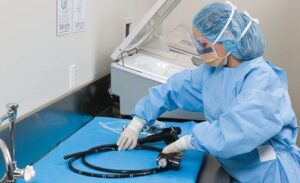 As Covid-19 continues to spread across the US and other countries around the world, hospitals must do all they can to prevent Covid-19 outbreaks within their walls. One potential way that Covid-19 could spread undetected is through the use of improperly disinfected endoscopes on patients.
As Covid-19 continues to spread across the US and other countries around the world, hospitals must do all they can to prevent Covid-19 outbreaks within their walls. One potential way that Covid-19 could spread undetected is through the use of improperly disinfected endoscopes on patients.
Cori Ofstead of Ofstead and Associates has been studying the effects of poorly disinfected scopes on patient safety for many years. The epidemiologist and researcher recently released some guidelines on how to properly reprocess bronchoscopes to keep patients free from any risk of Covid-19 infection. As this article by Judith M. Mathias at OR Manager discussed:
“Reusable bronchoscopes must be cleaned and disinfected or sterilized between uses. After a bronchoscope is used, the basic reprocessing steps recommended in standards include point-of-use precleaning, thorough mechanical or manual cleaning, high-level disinfection or sterilization, drying, and secure storage.
To ensure those steps work, basic quality checks must be performed. These checks are considered the five pillars of quality assurance and are recommended in national standards and guidelines:
- visual inspections
- leak testing
- cleaning verification tests
- minimum effective concentration tests or chemical or biological indicators for sterilized bronchoscopes
- drying verification tests.
The problem, Ofstead says, is that reprocessing quality in the field is very poor. Audits performed at three sites found:
- Site A did most of the steps properly, but their point-of-care precleaning and visual inspections didn’t meet the standards.
- Sites B and C did almost nothing in accordance with minimum standards and the manufacturer’s instructions for safely reprocessing bronchoscopes.
- Sites A, B, and C were handling patient-ready bronchoscopes with their bare hands.
- Sites B and C had dirty reprocessing and storage areas as well as inadequate dirty-to-clean workflow.
- Site B had intentionally disabled cycles in their automated endoscope reprocessors (AERs) to save time. “They turned off the cleaning cycle because it saved them 20 minutes, and it saved them money because they didn’t have to use any detergent,” says Ofstead.
- Site C skipped leak testing and manual cleaning and relied on their AERs to handle those steps.
Ofstead says in some cases, they saw nurses or technologists skipping a step. In one case, Ofstead took a bronchoscope out of a transport bin in the reprocessing area and found a thick, mucus-like residue all over the bin, and a closer look revealed blood clots amid the mucus.
“This did not bode well for reprocessing effectiveness because substantial blood and soil remained in the scope for a lengthy period of time after the procedure, potentially hardening in the channel and fostering the growth of biofilm,” Ofstead says.
She and her team also found the manual cleaning station in the reprocessing suite of a large urban hospital had multiple infractions, such as dirty sinks, puddles of pink fluid on the floor, discolored irrigation tubing filled with a brown substance, and faucets without foot pedals.”
Read the entire article here: Faulty bronchoscope reprocessing raises risks of infection transmission
As the article notes, hospitals must ensure staff are trained on general infection control principles and must adhere to reprocessing best practices. To ensure that your staff is following reprocessing best practices on every scope they disinfect or sterilize, install additional checks and balances into your workflow so that you can document that your staff is following the same process each time. Endoscope tracking software such as iRIScope has been introduced in recent years to help hospitals and surgery centers ensure that each of their flexible endoscopes is reprocessed the proper way each time, and documentation of their reprocessing is kept electronically using advanced RFID technology. These systems safeguard the scope disinfection process by employing artificial intelligence to determine if scopes are adequately reprocessed before their next use. With these systems in place, staff and patients can be more confident that their endoscope-related procedure won’t result in a life-threatening infection such as Covid-19.
